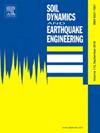A novel variability evaluation framework of seismic response for arch dams considering the influence of distribution modes of conditional spectra
IF 4.2
2区 工程技术
Q1 ENGINEERING, GEOLOGICAL
引用次数: 0
Abstract
This study aims to propose a novel method for selecting as-recorded near-fault (NF) impulsive ground motion based on the idea of “wavelet multiscale decomposition-matching target conditional spectrum (CS)”, and then study the influence of different distribution modes of target CS (corresponding to different record selection strategies) on the dispersion and bias of dynamic response of arch dams. First, the representative measured NF pulse-like earthquakes are decomposed into high-frequency non-pulse ground motions using wavelet multiscale decomposition techniques to match the different distribution modes of the target CS (conditional mean spectrum (CMS) plus and minus several times the standard deviation response spectrum). The different distribution modes of the CS reflect the statistical response spectra of different discrete degrees, which may reflect the uncertainty in choosing realistic ground motion. The nonlinear damage and cracking model of high arch dam-reservoir water-foundation system is used to analyze the response characteristics of the dam, and the key influencing factors, such as different distribution modes of the target CS and pulse characteristics, are considered. The dispersion and bias of the dam response index are evaluated by investigating the statistical distribution of each response index under different CS distribution modes. The results show that adjusting the distribution mode of the target CS may significantly affect the dispersion and bias of the structural response results of arch dams. When the distribution mode of the target CS changes, the scatter of the side joint opening (joint No. 1) is the smallest, and the bias variation range of the overall damage volume ratio is the largest. The scatter and bias of the response indices of pulsed motion are larger than those of non-pulsed motion. Therefore, when investigating the variability of arch dam dynamic response, the influence of NF pulse-type seismic motion and pre-selected target spectrum distribution mode cannot be ignored.
考虑条件谱分布模式影响的拱坝地震反应变异性评价框架
基于“小波多尺度分解-匹配目标条件谱”的思想,提出了一种选择近断层脉冲地震动记录的新方法,并研究了目标条件谱的不同分布模式(对应不同记录选择策略)对拱坝动力响应色散和偏置的影响。首先,利用小波多尺度分解技术将实测的具有代表性的NF脉冲型地震分解为高频非脉冲型地震动,拟合目标CS(条件平均谱,CMS)正负几倍标准差响应谱的不同分布模式;CS的不同分布模式反映了不同离散度的统计响应谱,这可能反映了实际地震动选择的不确定性。采用高拱坝-水库-水基系统非线性损伤开裂模型分析大坝响应特性,考虑了目标CS的不同分布模式和脉冲特性等关键影响因素。通过考察各响应指标在不同CS分布模式下的统计分布,评价大坝响应指标的离散性和偏倚性。结果表明,调整目标CS的分布方式可以显著影响拱坝结构响应结果的离散度和偏差。当目标CS分布方式发生变化时,侧面接缝开口(接缝1号)的散射最小,整体损伤体积比的偏置变化范围最大。脉冲运动响应指数的散点和偏置比非脉冲运动响应指数的散点和偏置要大。因此,在研究拱坝动力响应的变异性时,不可忽视NF脉冲型地震运动和预选目标谱分布方式的影响。
本文章由计算机程序翻译,如有差异,请以英文原文为准。
求助全文
约1分钟内获得全文
求助全文
来源期刊

Soil Dynamics and Earthquake Engineering
工程技术-地球科学综合
CiteScore
7.50
自引率
15.00%
发文量
446
审稿时长
8 months
期刊介绍:
The journal aims to encourage and enhance the role of mechanics and other disciplines as they relate to earthquake engineering by providing opportunities for the publication of the work of applied mathematicians, engineers and other applied scientists involved in solving problems closely related to the field of earthquake engineering and geotechnical earthquake engineering.
Emphasis is placed on new concepts and techniques, but case histories will also be published if they enhance the presentation and understanding of new technical concepts.
 求助内容:
求助内容: 应助结果提醒方式:
应助结果提醒方式:


